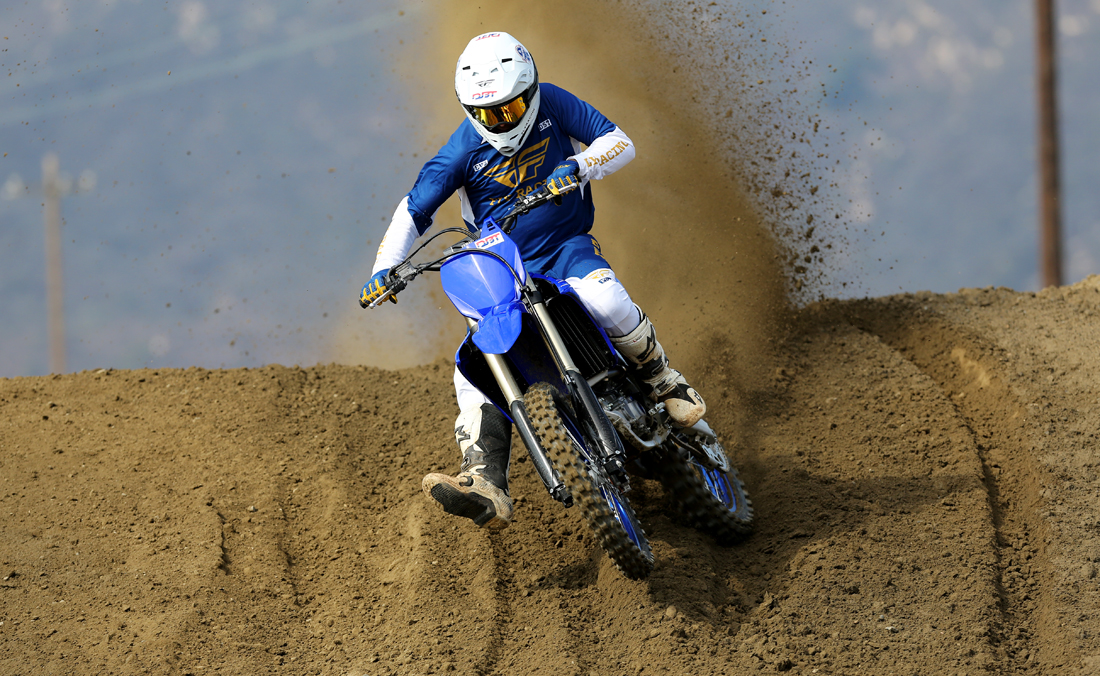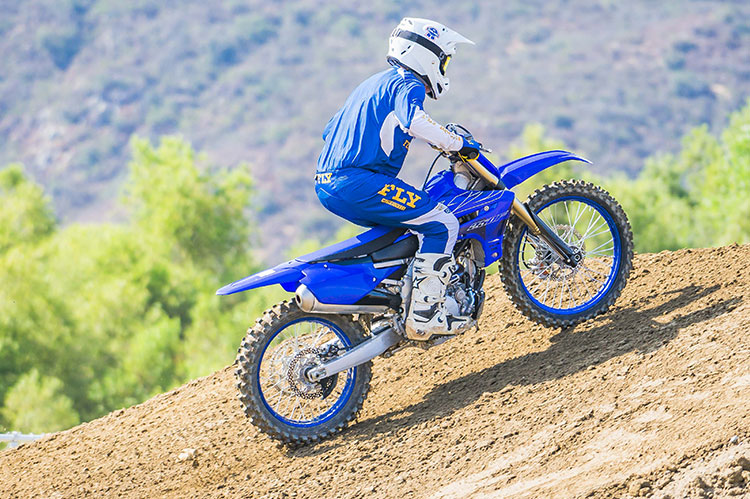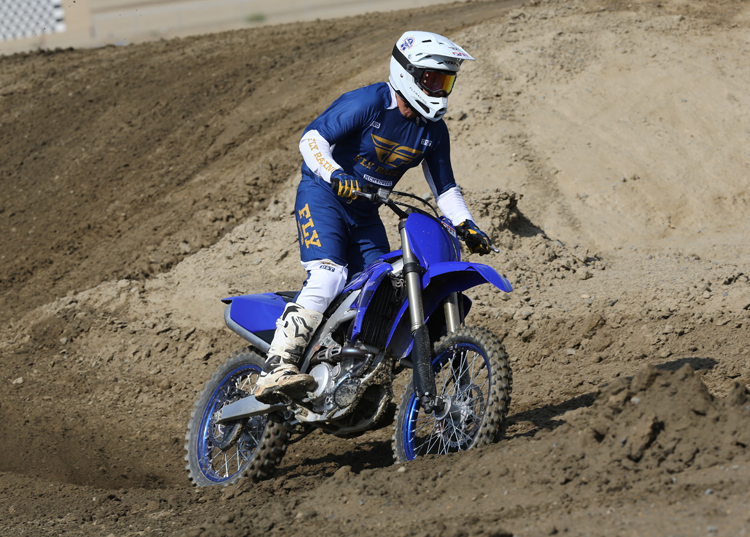Photos By Scott Hoffman and Tevor Hunter
Since the 2022 YZ250F is the same in the motor department, we’ll recap by simply saying this is the engine everyone is targeting, and for good reason. It puts out a wide spread of usable power that all ability levels can use, even pros. It has a more pronounced bottom-end pull than any other 250F, keeps that character into the mid-range where it is still class-leading, and then pulls to a very respectable top-end peak power that is challenged but not outdone. This is a bike class that is really all about power–so much so that other brands often sacrifice rideability for the regular rider in favor of seeking that power. Yamaha has this power in reserve and has not forgotten about it, even in the previous upgrades that did focus on upper-end power.
If there is anything to complain about with the motor, it is that in the stock map the bike now runs into a much more sudden or pronounced rev limiter where in the past (and it seems other manufacturers are going back towards what Yamaha had) the rev cut was softer and more gradual.
Then we can bring up the Yamaha Power Tuner and map select switch. The free app and included two-position, switch on the fly (like it NEEDS TO BE) map switch is a feature that takes the power advantage and keeps on shoving it down the competition’s throat. You can tune the style of the power delivery in so many ways, even the sudden rev cut we mentioned above can be lessened with some additional fuel and less ignition advance high in the RPM range with a few minutes on the free phone-based app. Want more throttle excitement and some better pull for riding a gear high (this is the only 250F you can really ride a gear high without abusing the clutch)? Place the “aggressive” map, which is saved in the Power Tuner App, in the number two position on the map switch and by simply pushing the button you get it. Currently, this is like cheating or picking on the other bikes in the class, but it comes stock.
The clutch pull is light, the shifting was pretty amazing allowing clutchless wide-open changing on rough straights. The gearing is spot on for most riders and conditions with no complaints from us at Fox Raceway. Likely we have gotten used to the noise coming from the gas tank area because it didn’t bother any of our riders like it has in the past. The muffler does a decent job and the sound output is typical. 
The improvements for 2022 center on two things. The first is a wider rear rim and likely stiffer overall rear wheel with a triple-cross spoking pattern. This is common technique for building stronger wheels. In our experience, Yamaha takes these changes seriously from a performance side above how they look on the marketing materials. The wider rim spreads the tire out better and for a bike with this power delivery, that is a good thing, the additional traction is welcome and it complements the bike. We did not do back-to-back with the older style wheel but we did not feel anything adverse in the rear of the YZ so we’re going to have to say it didn’t do anything bad.
The second change is the altering of the suspension valving settings inside of the fork and the clicker changes for the shock to better stabilize the bike from transferring weight front to back entering and exiting the turns. Pitching is the term Yamaha uses. A small change for sure it seemed, in our one-day riding impression, to do that. The suspension was already really good for a wide variety of riders. If anything, it has been getting stiffer overall and this change is in a stiffer direction yet. But we can’t complain about the pitching of the bike even when comparing it to other bikes. And especially compared to a few year’s older generation YZs, it has improved. 
Mostly for learning, we started deviating from standard suspension settings and wanted to try and dial in a little more “comfort”–or going a bit softer for the track that was developing choppy bumps. We opened up rebound and compression on the front and rear, a typical move to get a softer feel and it got way worse! Especially for heavier riders. So we countered by going to a stiffer setting on the low-speed compression side and the comfort got better. This stiffening to get a softer feel is typical of bikes that may be riding a little deep in the stroke to begin with. Even though the YZ did not feel low, we were pretty surprised how well this worked and this “stiffer” setting was praised by most riders, especially the setting in the shock. To top it off the high-speed compression on the shock can work wonders for getting the bike to turn into corners. So if your happy suspension setting has the bike getting lazy into the turns, adding (to get more turning) or decreasing HS compression (for less turning precision or more stability overall) works wonders. This was typical on both 250 and 450. Our lighter weight tester who kept the bike higher in the stroke purely on less weight felt decreasing high-speed compression outback by ¼ turn helped with stability and settled the rear end in acceleration chop. It gave the bike some needed comfort and traction in the square-edged, hard-pack track conditions.
The latest generation YZ250F feels lighter and more nimble compared to the last generations and in a class that is secondly about being light feeling and flickable, the Yamaha is middle ground. Once you get used to it, you won’t have anything to complain about. But coming off other bikes, there is a slight visual effect from the front of the bike appearing wider than the competition. The basis of the bike can feel a little more front-heavy than others as well. Yamaha has always had a spring fork front end, not air, so they never got into the super-light front end arena and this has stayed constant where other brands have had noticeable changes in weight feel over the past few years. 
Most riders liked the layout overall and there were not any standout attention grabbers. It is easy to move around on the bike, the bars, levers, and seat all fit the package. The now-standard #3 position of the bars in the top clamp seems normal and opens up the rider triangle just a little more. The brakes were plenty strong and had a great feel.
Since everything besides the power is really good and does nothing really wrong, this YZ250F is going to be a tough bike to beat. The power is another story. Especially for the majority of riders who are not pro-level riders. Pros rarely run stock motors anyways and are looking for a performance level in an area of the powerband that is not visited much by the average Joe. Trust us, your typical “test rider” does not understand this when they break down the performance of a bike. Understand that many riders feel they are riding in a power zone compared to where they are actually riding is something that most ride reports overlook. If you’ve ridden a recent Yamaha YZ250F you realize this power feeling–then not much has changed here from the Blue Crew. But if you are the competition, you are focusing your power improvements based on this $8499 Yamaha YZ250F. That is what you really need to know.
Learn More: https://www.yamahamotorsports.com/motocross/models/yz250f

Do You Like DBT bringing you fresh content? Search and shop through the links below:

